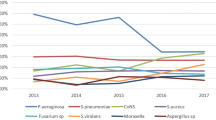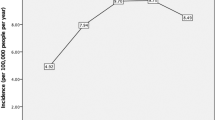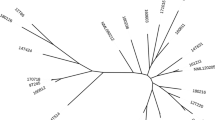Abstract
Purpose
To report the predisposing factors, clinical profile, and treatment outcome of patients with keratitis that was caused by a rare species of Nocardia.
Methods
Between April 2006 and October 2008, medical and microbiology records of patients with keratitis that was caused by Nocardiawere reviewed. Isolates were identified to species level by 16S rRNAgene sequencing, and antibiotic susceptibility testing was performed by E-test to amikacin, azithromycin, clarithromycin, ciprofloxacin, gatifloxacin, and tobramycin.
Results
Of 19 cases with Nocardiakeratitis, 8 were caused by unusual isolates. Species distribution among the eight isolates was as follows: the Nocardia levis(2 of 8), Nocardia amamiensis(2 of 8), Nocardia abscessus(1 of 8), Nocardia puris(1 of 8), Nocardia beijingensis(1 of 8), and Nocardia thailandica(1 of 8). All eight (100%) isolates were sensitive to amikacin and tobramycin. Trauma to the cornea was the major predisposing factor in seven of the eight patients. Five patients presented with the characteristic wreath-pattern infiltrate. The infection resolved to topical therapy with amikacin sulphate (2.5%) in six patients, whereas two patients treated with the same antibiotic were lost to follow-up at a point when the lesion was showing signs of resolution.
Conclusion
The healing response in Nocardiakeratitis cases was the same, irrespective of species.
Similar content being viewed by others
Introduction
Organisms of the genus Nocardia are a rare cause of infectious keratitis.1 Various species described to cause keratitis include Nocardia asteroides, Nocardia arthritidis, Nocardia pseudobrasiliensis, Nocardia gypsoides, Nocardia farcinica, Nocardia caviae, Nocardia cyriacigeorgica, and Nocardia otitidiscaviarum.1, 2 In this study, we report the predisposing factors, clinical profile, and treatment outcome of keratitis caused by other rare species of Nocardia.
Methods
We reviewed microbiology records of patients with keratitis examined at the L. V. Prasad Eye Institute (Hyderabad, India) between April 2006 and October 2008. Out of 4918 suspected cases of microbial keratitis, 2001 were culture proven. Of the 2001 culture-proven cases, the growth of Nocardia was observed in 19 (0.9%) cases during the study period. All 19 isolates were subjected to identification by gene sequencing of 16S rRNA. Review of the published literature in English using PubMed showed that eight of these isolates that were identified by gene sequencing have never been reported. We conducted a retrospective review of medical records of all these cases.
All patients underwent a detailed clinical evaluation. They were subjected to corneal scrapings, and the material was subjected to standard microbiology procedures as described previously.3
Genetic identification was performed by amplifying a 606-bp fragment of the 16S rRNA gene of Nocardia as described by Rodriguez-Nava et al4 Sequencing was performed with fluorescence-labelled dideoxynucleotide terminators using an ABI 3130 Xl automated sequencer, following the manufacturer's instructions (PE Applied Biosystems, Foster, CA, USA). Sequences were analyzed and identified using the MEGABLAST search program of GenBank databases and Bibi software (http://pbil.univ-lyon1.fr/bibi). An isolate was assigned to a particular species if the 16S rRNA sequence of the isolate was >99% similar to the type strain of the most closely related species, indicated by both NCBI BLAST and Bibi database programs. In vitro antibiotic susceptibility was determined using the E-test (AB Biodisk, Solna, Sweden), and test results were interpreted according to the CLSI guidelines (approved standards M24-A: CLSI 2009).
The Institutional Review Board of the L.V. Prasad Eye Institute (Hyderabad, India) approved this study.
Results
Species of Nocardia, their percentage similarity with known strains deposited in the GenBank, and in vitro antimicrobial susceptibility results are shown in Table 1. Minimum inhibitory concentration (MIC)90 values were 0.75 μg/ml for amikacin, 1 μg/ml for tobramycin, 08 μg/ml for both ciprofloxacin and gatifloxacin, and 16 μg/ml for both azithromycin and clarithromycin. Predisposing factors, clinical picture, and treatment outcome of all the eight patients are shown in Table 2. All patients presented with complaints of pain, redness, and watering from 4 days to 2 months duration. Trauma was the major predisposing factor in seven of the eight patients. Five patients presented with the characteristic wreath-pattern infiltrate. All patients were treated with topical amikacin sulphate (2.5%). The infection resolved in six patients, whereas two patients were lost to follow-up at a point when the lesion was showing signs of resolution.
Discussion
Analysis of gene sequences has contributed to our understanding of the phylogenetic relationships of Nocardia and has resulted in the recognition of numerous new species.5 Various molecular methods used for the identification include gene sequencing of 16S rRNA and hsp65, pyrosequencing of 16S rRNA and ribotyping.2, 5 Although Yin et al2 reported hsp65 gene sequencing as the more reliable method, there is no consensuses on the superiority of one over the other.
To the best of our knowledge, this is the first report describing the predisposing factors, clinical picture, and treatment outcome of microbial keratitis caused by Nocardia levis, Nocardia puris, Nocardia thailandica, and Nocardia amamiensis. Although N. levis and N. amamiensis were not isolated from human infections,6, 7 N. puris and N. thailandica were isolated from patients with abscess and choroiditis.8, 9
Trauma to the cornea was a major predisposing factor in this study, a finding similar to that of Lalitha et al10. Five of these eight patients presented with characteristic patchy anterior stromal infiltrates surrounded by yellow white discrete pinhead-sized lesions arranged in a wreath pattern, similar to that described for other reported species.1, 10
Although Lalitha et al10 reported that the wreath pattern is more commonly seen in patients presenting within weeks of the onset of symptoms, two patients in our series had this clinical picture in spite of delayed presentation (patient nos 2 and 4).
All the newly identified isolates in this series were sensitive to amikacin and tobramycin, but MIC90 values of tobramycin were higher than those of amikacin. In a recent report, Pandya and Petsoglou11 reported a case of amikacin resistant Nocardia transvalensis keratitis. Similarly, Eggnik et al12 reported increased morbidity in keratitis due to N. farcinica because of its inherent resistance to antibiotics. In this series, the infection in all patients responded favourably to amikacin sulphate (2.5%) therapy, a finding similar to that reported by Lalitha et al10
Conclusions
Keratitis in humans can be caused by various Nocardia species. The healing response in Nocardia keratitis cases was the same, irrespective of species.

References
Sridhar MS, Gopinathan U, Garg P, Sharma S, Rao GN . Ocular Nocardia infections with special emphasis on the cornea. Surv Ophthalmol 2001; 45: 361–378.
Yin X, Liang S, Sun X, Luo S, Wang Z, Li R . Ocular Nocardiosis. HSP65 gene sequencing for species identification of Nocardia species. Am J Ophthalmol 2007; 144: 570–573.
Sridhar MS, Sharma S, Garg P, Rao GN . Treatment and outcome of Nocardia keratitis. Cornea 2001; 20: 458–462.
Rodriguez-Nava V, Couble A, Devulder G, Flandrios JP, Boiron P, Laurent F . Use of PCR restriction enzyme pattern analysis and sequencing database for hsp 65 gene based identification of Nocardia species. J Clin Microbiol 2006; 44: 536–546.
Brown-Elliott BA, Brown JM, Conville PS, Wallace Jr RJ . Clinical and laboratory features of Nocardia spp based on current molecular taxonomy. Clin Microbiol Rev 2006; 19: 259–282.
St Leger J, Begeman L, Fleetwood M, Frasca S, Garner MM, Lair S et al. Comparative pathology of Nocardiosis in marine mammals. Vet Pathol 2009; 46: 299–308.
Yamamura H, Tamura T, Sakiyama Y, Harayama S . Nocardia amamiensis sp.nov., isolated from a sugar cane field in Japan. Int J Syst Evol Microbiol 2007; 57: 1599–1602.
Watanabe K, Shinagava M, Amishima M, Lida S, Yazawa K, Kagayama A, Ando A, Mikami A . First clinical isolates of Nocardia cornea, Nocardia elegans, Nocardia paucivorans, Nocardia puris and Nocardia takedenisis in Japan. Jpn J Med Mycol 2006; 47: 85–89.
Kageyama A, Poonwan N, Yazawa K, Suzuki S, Kroppenstedt RM, Mikami Y . Nocardia vermiculata sp.nov. and Nocardia thailandica sp.nov., isolated from clinical specimens. Actinomycetolgica 2004; 18: 27–33.
Lalitha P, Tiwari M, Prajna NV, Gilpin G, Prakash K, Srinivasan M . Nocardia keratitis, species, drug sensitivities and clinical correlation. Cornea 2007; 26: 225–259.
Pandya VB, Petsoglou C . Nocardia transvalensis resistant to amikacin: an unusual cause of microbial keratitis. Cornea 2008; 27: 1082–1085.
Eggnik CA, Wesseling P, Boiron P, Meis JFGM . Severe keratitis due to Nocardia farcinica. J Clin Microbiol 1997; 35: 999–1001.
Acknowledgements
This study was supported by the Hyderabad Eye Research Foundation.
Author information
Authors and Affiliations
Corresponding author
Ethics declarations
Competing interests
The authors declare no conflict of interest.
Rights and permissions
About this article
Cite this article
Reddy, A., Garg, P. & Kaur, I. Spectrum and clinicomicrobiological profile of Nocardia keratitis caused by rare species of Nocardia identified by 16S rRNA gene sequencing. Eye 24, 1259–1262 (2010). https://doi.org/10.1038/eye.2009.299
Received:
Revised:
Accepted:
Published:
Issue Date:
DOI: https://doi.org/10.1038/eye.2009.299
Keywords
This article is cited by
-
Nocardia transvalensis keratitis: an emerging pathology among travelers returning from Asia
BMC Infectious Diseases (2011)
-
Clinical and microbiological characteristics of infections caused by various Nocardia species in Taiwan: a multicenter study from 1998 to 2010
European Journal of Clinical Microbiology & Infectious Diseases (2011)



